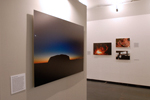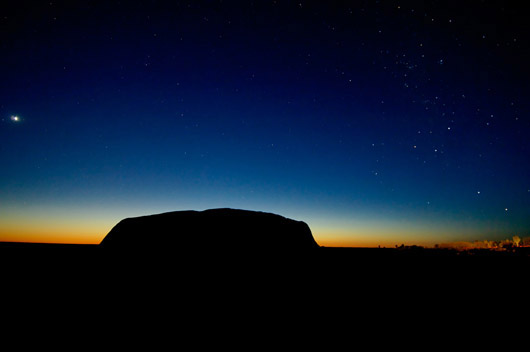Australia,
sulle tracce di Chatwin venti anni dopo Le Vie dei Canti
Palazzo Ducale, Genova
Australia, in Chatwin's footsteps twenty years
after The Songlines
Palazzo Ducale, Genoa


Il
sole che sorge lascia ancora intravedere le ultime stelle della notte.
La Croce del Sud è bassa, quasi sull’orizzonte, sul lato
del monolite vicino alla strada che inizia a essere rischiarata dalle
luci delle auto e dei bus carichi di turisti che vengono ad assistere
allo spettacolo dell’alba. Venere brilla solitaria sul lato opposto.
Il totem è lì da milioni di anni. Punta di un iceberg di
arenaria alto 348 metri sulla pianura circostante, profondo il doppio
della sua altezza sotto la sabbia. Luogo sacro agli aborigeni, sacralizzato
da visitatori occidentali e orientali da quando dagli anni ‘40 è
cominciato il grande affare del turismo. Uluru o Ayer’s Rock (come
lo battezzò nel 1873 William Gosse, primo bianco a “scoprirlo”)
continua ad attrarre magneticamente. Mezzo milione di persone arrivano
ogni anno per vederlo, toccarlo, scalarlo. Anche Chatwin. Nel 1985 (l’anno
della restituzione di Uluru ai legittimi proprietari tradizionali, gli
Anangu). Lui e Salman Rushdie, entrambi invitati dal festival di letteratura
di Adelaide, come due turisti qualsiasi vanno in macchina verso la grande
roccia. Chatwin la scala, vantandosi di aver battuto degli svizzeri nell’andare
su e giù (Rushdie nega). Gli Anangu invitano a non salire sulla
roccia. Il cammino è lo stesso percorso dall’antenato Mala
al suo arrivo qui nell’epoca della creazione. Ma molti intraprendono
la salita. Agevole ma impegnativa quando fa caldo e tira vento (malgrado
venga chiusa in condizioni climatiche critiche, si registrano diverse
morti l’anno). Alcuni vanno su attrezzatissimi; altri, in short
e sandali. La maggioranza sembra giapponese, molti con guanti e mascherine.
Una connazionale, hostess di un bus, li aspetta alla base e offre di fare
una foto ricordo. Tutti accettano. Posa, scatto e via verso il trofeo
da riportare a casa